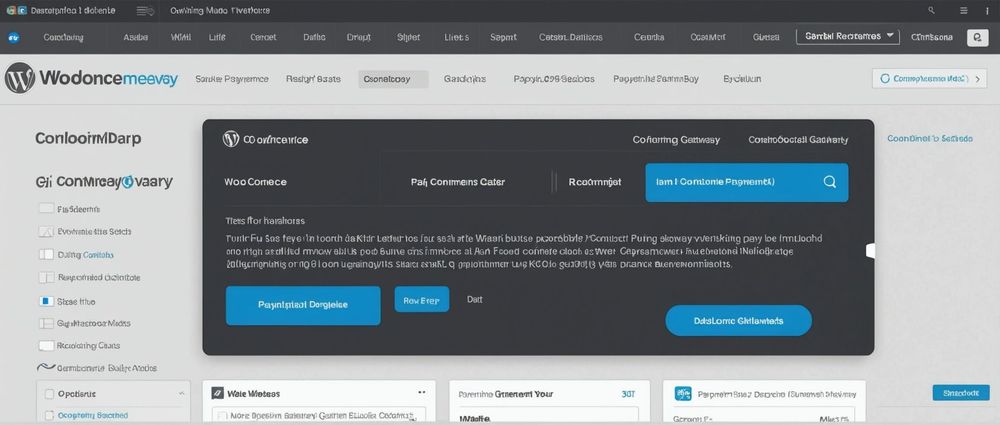Choosing and adding the right payment gateway to your WooCommerce store is essential for smooth financial transactions. This article will explore various WooCommerce payment gateways and provide detailed steps on how to integrate them with your WordPress site.
Understanding WooCommerce Payment Gateways

WooCommerce payment gateways are third-party services that facilitate online payments between customers and merchants. They support various payment methods, including credit cards, debit cards, bank transfers, and digital wallets. A reliable payment gateway ensures secure and efficient transactions, which is crucial for building customer trust and enhancing the shopping experience.
Popular examples include PayPal, Stripe, Square, and Authorize.net. Each of these gateways comes with its own set of features, fees, and integration processes. The choice of the payment gateway can greatly impact the functionality and user experience of your e-commerce store, so it’s important to make an informed decision.
Key Factors to Consider When Choosing a Payment Gateway

When selecting a payment gateway for your WooCommerce store, several factors need to be taken into account. First, consider the transaction fees. Different gateways have different fee structures, which can affect your overall cost. Second, assess the supported payment methods. Ensure that the gateway supports the payment options your target customers prefer.
Third, evaluate the security features. The gateway should be PCI-DSS compliant and offer secure encryption to protect sensitive customer data. Fourth, take into account the ease of integration with WooCommerce. The smoother the integration, the quicker you can start accepting payments. Lastly, consider the customer support provided by the gateway. Efficient support can help resolve any issues promptly, ensuring uninterrupted service.
Popular WooCommerce Payment Gateways
Several payment gateways are commonly used with WooCommerce. Here’s a brief overview of some of the most popular options:
PayPal:
One of the most widely used payment gateways, offering broad customer trust and easy integration.
Stripe:
Known for its developer-friendly API and seamless user experience; supports a variety of payment methods.
Square:
Ideal for businesses that also have a physical presence, providing excellent point-of-sale solutions.
Authorize.net:
A robust solution with advanced features but slightly more complex to set up.
Steps to Add a Payment Gateway to WooCommerce

Adding a payment gateway to your WooCommerce store involves several steps. While the process may vary slightly depending on the chosen gateway, the basic steps remain the same. Here’s a general guide:
Install and Activate WooCommerce:
Make sure WooCommerce is already installed and activated on your WordPress site.
Select and Install Payment Gateway Plugin:
Go to the WordPress dashboard, navigate to Plugins > Add New, and search for your chosen payment gateway plugin (e.g., WooCommerce PayPal).
Activate the Plugin:
Once you find the plugin, install and activate it.
Configure the Payment Gateway:
Go to WooCommerce > Settings > Payments, and click on the relevant payment gateway to configure its settings. Enter all required information, such as API keys, merchant ID, etc.
Test the Payment Gateway:
Conduct a test transaction to ensure everything is working correctly.
Advanced Tips for Integrating Payment Gateways
For a more seamless integration, consider the following advanced tips. First, use sandbox accounts for testing. Most payment gateways offer sandbox environments where you can perform test transactions without processing real payments. This helps you identify and fix any issues before going live.
Second, optimize checkout flows to minimize cart abandonment. A streamlined, user-friendly checkout process can improve conversion rates. Third, stay updated with the latest gateway features and updates. Regularly check for plugin updates and new features that can enhance your payment processing capabilities. Fourth, use analytics to track payment performance. Monitoring metrics like transaction success rate and average transaction value can provide valuable insights into your payment process.
Conclusion
WooCommerce payment gateways are key to seamless and secure financial transactions on your e-commerce store. By carefully selecting the right gateway and following proper integration steps, you can provide a smooth and trustworthy shopping experience for your customers. Always consider factors like transaction fees, supported payment methods, and security when choosing a gateway, and leverage advanced tips for optimal performance.
FAQ
1. What is the best WooCommerce payment gateway?
The best WooCommerce payment gateway depends on your specific needs. Popular choices include PayPal, Stripe, Square, and Authorize.net, each offering unique features and benefits.
2. Can I use multiple payment gateways with WooCommerce?
Yes, WooCommerce allows you to integrate multiple payment gateways, giving your customers various payment options during checkout.
3. How much do payment gateways charge in transaction fees?
Transaction fees vary by gateway. For example, PayPal and Stripe typically charge around 2.9% + $0.30 per transaction, while other gateways may have different fee structures.
4. Do I need a merchant account to use a payment gateway?
Some gateways, like Stripe, include a merchant account as part of their service. Others, like Authorize.net, require you to have a separate merchant account.
5. How do I test my WooCommerce payment gateway integration?
Most payment gateways provide sandbox environments for testing. You can conduct test transactions using sandbox accounts to ensure the integration works correctly before going live.